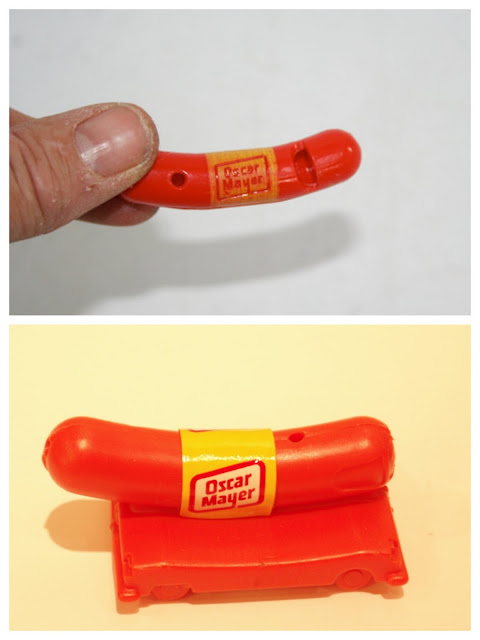In another blog post, I featured the Oscar Meyer Wienermobile (see above) and the coveted whistles its occupants passed out to us kids. I think the corporate rule was “one Wienerwhistle per kid,” because getting two of them was an uncommon occurrence. Sometimes, if the crowd was big enough, and the Wienermobile stayed for two days, you might score one on each day.
For those of you youngsters reading this, I’m talking late 1950s-early 1960s here. Our TV antenna might manage 4 stations—ABC, CBS, NBC, and an independent English station in Mexico. But, we only got all four on the same day when all the stars were aligned. So, the Wienermobile was a big deal.
The design of the whistle is simple.
- Start with an outside of a round-ended closed cylinder.
- Drill a hole at each end of the cylinder.
- Drill a hole about one-third of the way down the length of the cylinder.
- Cut a wedge-shaped opening closer to the other end than the previous hole, but make sure it is open in the same direction as the previous hole.
- While neither example shows all the holes, all four are present in every Wienerwhistles.
Once you got your Wienerwhistle, you had to play it. Over. And over. And over. Much to the dismay of adults in your household.
To play the Wienerwhistle,
- Hold the end of the whistle closest to the wedge-shaped opening between your lips with the wedge-shaped opening facing up.
- Blow into the hole between your lips. A sound will emerge.
- Cover the end hole with a finger.
- Repeat Step #2. A different sound will emerge.
- Remove your finger from the end hole and use it to cover the hole facing up.
- Repeat Step #2. Yet another different sound will emerge.
- Finally, keep one finger covering the hole facing up and use another finger to cover the hole in the end.
- Repeat Step #2. Violà! A fourth sound will emerge.
You now know the potential of the instrument.
Notice I used the term sound and not note for the compression waves generated by your moving breath. That’s because I don’t know if they are notes. I’ve never heard anything like music played on one. Mostly what the Wienerwhistle produces are annoying sounds. Remember the previous sentence.
In most houses, the life span of a Wienerwhistle was less than 24-hours. No matter how clever you were at hiding your whistle, sometime during the first night the whistle spent in your house, something like what follows would occur. I’m using Dad as the designated parent because I’m pretty sure that’s the way it was in my house when wienerwhistles were concerned.
Typical Sequence of Events the Night After Receiving a Wienerwhistle
- Hide your whistle in your underwear drawer before going to bed.
- Wrap it in a sock or a pair of tighty-whities.
- Push it all the way to the back of the drawer.
- Cover the hidden whistle with other underwear.
After he’s sure you’ve gone to sleep,
- Dad will enter your room.
- With the stealth that a cat-burglar would envy, he will search your entire room: closets, drawers, boxes, baseball card stashes, comic book racks. If it has a place to hide something, he’ll search it.
- He will find the source of the annoying sounds—your Wienerwhistle.
- He will take his prize out into the hallway or living room.
- He will drop in on the carpet.
- He will smash the Wienerwhistle to smithereens with his shoe-covered foot.
- He will go to bed.
In the morning, when you wake up and can’t find your Wienerwhistle,
You will ask your parents,
“Have you seen my Wienerwhistle?”
Dad will answer,
“No. But I felt it when I stepped on the thing in my bare feet last night. I think I broke. I warned you to keep it off the floor.”
You know you have no chance of winning an argument about what really happened. So, you go to your friends and see if they were any more successful than you were at hiding their whistle(s).
Chances are all they can offer you is a handful of broken plastic pieces and a tube of airplane glue.
PS. I was going to record me playing my Wienerwhistle and link it as an MP3 file. But, my wife says she hasn’t seen it in a long time.
SOE: Weinerwhistle, 1950s, toys
SOE: Weinerwhistle, 1950s, toys
Next? maybe Duncan Yo-yos and the Yo-yo Masters
and Facebook: https://www.facebook.com/CRDowningAuthor
E-mail: crd.author@gmail.com














